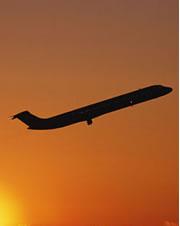 Is it the air, or just sitting still, that makes plane trips potentially dangerous?© Getty
Is it the air, or just sitting still, that makes plane trips potentially dangerous?© GettyA study of the effects of low oxygen levels on 'economy class syndrome' has re-opened the debate over how long-haul flights increase passengers' risks of deep vein thrombosis (DVT), the formation of potentially fatal blood clots.
Although it is well known that restricting blood flow by sitting immobile for long periods can increase the risk of such clots, some researchers have proposed that there may be other factors on flights that contribute to the risk.
Studies comparing people on long-haul flights to those sitting still on the ground have indicated that there is a difference between the two groups, although it isn't clear exactly why. Researchers have suggested that the explanation could lie with passenger stress, poor air quality, low humidity, low air pressure, or exposure to cosmic radiation.
William Toff, from the University of Leicester, UK, decided to follow up on the notion that low air pressure, and thus low levels of oxygen, might be to blame. But after subjecting volunteers to low pressures, his team found no evidence that this had an impact on their risk of clotting.
High flyers
More than 70 healthy volunteers participated in Toff's study, each spending two eight-hour sessions in a pressure chamber. One session was at the normal air pressure of ground level, while the other was at low air pressure conditions equivalent to that at an altitude of 2,438 metres, which Toff says is the lowest pressure allowed in cabins under international flight regulations.
"This cabin pressure represents the worst case scenario to which passengers might be exposed," says Toff, adding that most long-haul jetliners at cruising level typically maintain cabin pressure at an altitude equivalent of 1,524 to 2,134 metres.
Blood was drawn from the volunteers before and after each of the two sessions to test four markers of the early signs of blood clotting. The researchers found no significant difference between the two groups, they report in the Journal of the American Medical Association1.
Toff says he thinks the prime cause of DVT in long-distance travel by air, rail or car is simply "prolonged, seated immobility".
Cramped cabins
But others aren't ready to call an end to the question. Suzanne Cannegieter, co-author of a study published recently in The Lancet concluding that cramped jet cabin conditions are not the sole cause of DVT2, says she still thinks that an effect of low cabin oxygen cannot be excluded as a contributing factor.
Cannegieter and her colleagues at the Leiden University Medical Center in the Netherlands have shown that blood samples taken from participants at a relatively high risk of DVT (such as women on the birth-control pill or those with a genetic predisposition) who spent eight hours flying showed more signs of coagulation than the same people confined for eight hours in cinema seats.
Cannegieter points out that some previous studies have suggested an effect of low oxygen levels on blood clotting. She says this is still the most likely candidate to explain problems during air travel.
High risk, low pressure
Both Toff's and Cannegieter's teams are now interested in looking at high-risk volunteers in low-pressure chambers, to get a better picture of any possible link.
ADVERTISEMENT
Their work could be helped by a new flight-simulator laboratory, built around a section of an Airbus 310, which was officially inaugurated earlier this month at the Fraunhofer Institute for Building Physics (IBP) in Holzkirchen, Germany. Andreas Hagen Holm, from this institute, says it is the first ground-based system to simulate cabin conditions of aeroplanes as high as 13,000 metres. The simulator should help researchers to unpick the various influences of things such as vibrations, noise pollution, air quality and pressure on human health.
In the meantime, advice to passengers remains the same: make sure to move around while on a long flight. As Toff spoke to news@nature.com he was due to take a trans-Atlantic flight Tuesday evening to Boston; he said that he would regularly be contracting his calf muscles and walking around the cabin during his trip.
Visit our causesbloodclotson_lon.html">newsblog to read and post comments about this story.
